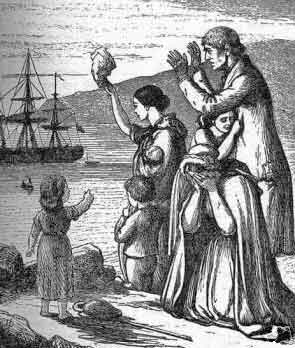The song Skibbereen describes how mass evictions of the Irish poor and the need to escape starvation during the famine forced more than a million people to leave the country.
Skibbereen
Skibbereen Videos
Lyrics and Chords
Emigration and deaths from the famine reduced Ireland’s population by approximately two million in the mid-19th century. It still hasn’t fully recovered.
People risked perilous journeys on ‘coffin ships’ to build a new life in countries like the United States, Australia and the United Kingdom.

The population of Ireland still remains lower today than it was before the Famine of 1845-1848.
In the fifth verse of Skibbereen, the father mentions the year of “forty-eight, when I arose with Erin’s boys to fight against the fate”.
This refers to the Young Irelander Rebellion of 1848 – a brief and unsuccessful uprising against British rule. It took place against the background of revolution that was taking place across Europe.
It was also, of course, given extra impetus in Ireland by the Famine and the fact that so many Irish people were being thrown off their land by absentee British landlords.
The rebellion was led by a group of young nationalists including William Smith O’Brien, Michael Doheny and Thomas Meagher. They hoped to establish an independent Ireland but the uprising was quickly put down at a small village called The Commons near to Skibbereen. Those who took part had to flee, as the father mentions in the sixth verse.
Skibbereen ends with a promise from the son

The song ends with the son vowing to avenge his father’s suffering by leading a rebellion to secure Irish independence.
Ireland did eventually become independent but not until the 1920s – more than 70 years after the events of Skibbereen.
The song Skibbereen is not about a specific person; it’s a song that sums up the events of the Famine and the Young Irelander Rebellion as seen through the eyes of a father and son living abroad, probably in America.
The first known published version of the song appeared in The Irish Singer’s Own Book (Noonan, Boston 1880. It’s attributed to a poet from Skibbereen called Patrick Carpenter.
The Heritage Centre at Skibbereen has an audio-visual exhibition telling the story of the Irish famine.
The Sean Nos singer Joe Heaney helped popularise the song again in Ireland in the 1950s and it was then taken up by a host of other notable Irish performers including the Dubliners, The Wolfe Tones and Sinead O’Connor.
 Skibbereen
Skibbereen
Wave of emigration from Ireland
Skibbereen Videos
Lyrics and Chords